Rape Culture/Relationship Abuse Culture is a culture that accepts and supports gender based violence and men’s use of violence against womxn. Abuse is not a natural result of anger problems or alcohol—it is a learned behavior that operates within a larger context. Ideas, customs, and institutions influence the acceptance of gender based violence. A number of social forces act on the individual to breed misogyny and shape ideas about male dominance, and the devaluation and dehumanization of women, transgender, genderqueer and nonbinary individuals, which can normalize abusive behavior. Relationship Abuse/Rape Culture is made up of many interrelated societal phenomena, that include objectification, misogyny, victim blaming, and gender role expectations. Rape culture is the desensitization of and acceptance of men’s violence against womxn as normal. Advertisements, movies, video games, the mishandling of court cases, etc. have contributed to this desensitization of gender based violence and the examples below demonstrate how society minimizes, trivializes, and even encourages rape and abuse. Below, interns and staff have written about and given examples of:
- Objectification of womxn in the media
- Misogynistic lyrics, advertisements, and social media pages
- Elliot Rodgers’ misogyny and incels
- Sexism in video games: Grand Theft Auto
- Victim-blaming
- Lack of accountability for perpetrators
- Gender roles and expectations
- Trans-misogyny
For information on how you can fight rape culture:
- Check out a TedTalk on how societal ideas of masculinity contribute to the acceptance of men’s violence against womxn.
- Check out tips for how media professionals can combat rape culture.
- Check out Feminism in Action and see how you can help combat rape culture.
Warning: This page contains disturbing imagery and violent lyrics
Objectification of womxn is a large part of relationship abuse/rape culture and has serious consequences. When people see their partners as objects, they are more likely to see them as a personal possession rather than an individual. People do not beat or rape “humans”; they beat or rape “objects.” As long as womxn are seen as objects, they will continue to be seen as “things” to beat and rape in our society. Womxn are still portrayed as objects in the media and seen as objects in mainstream society. Objectification of womxn and sexualization of violence occurs in advertisements, music videos, video games, movies, pornography, and in various interactions (sexist language, catcalling, etc). The examples below portray women as sexually available, submissive, interchangeable with other women, while men are displayed as aggressive, dominant, and violent. These sorts of examples are everywhere, and they send a message that womxn are objects for men to act upon violently and sexually. In addition, objectification also makes it harder to empathize with womxn who have experienced abuse or sexual violence.
Street harassment is not a compliment. It degrades and objectifies womxn, stemming from the concept that womxn exist to please men and that men are entitled to their bodies. Click here for an informative graphic on how sexual harassment plays into the big picture.




Robin Thicke’s Blurred Lines has been called a “rape anthem,” and rightly so. This song mocks consent and sends a message that “no matter what you say or do, I have decided that you want to have sex with me.”
Both misogyny, hatred and distrust towards all women, and sexism can be driving factors for objectification, victim blaming, sexism, and transphobia in general, but our culture also accepts blatantly misogynistic messages that contribute to rape and abuse of womxn. Rape culture includes behaviors and attitudes that are fueled by trans-misogyny, which refers to the hatred of trans women. Misogynistic and sexist lyrics, images, and discourse are everywhere, and until misogyny and cissexism are eliminated from our culture, sexual assault and dating violence will continue to occur.
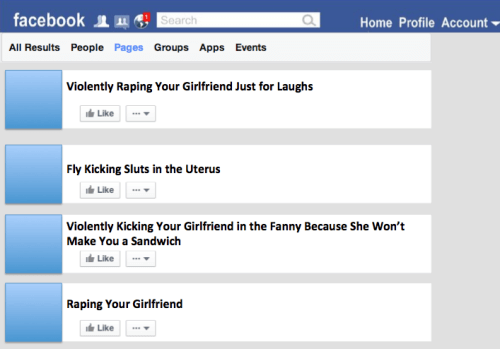

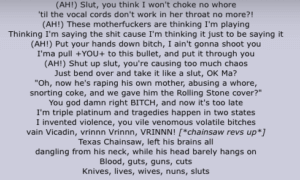

In May of 2014, Elliot Rogers went on a shooting rampage in Santa Barbara, in an attempt to kill sorority women, killing seven people including himself. Here is an excerpt from his journal:
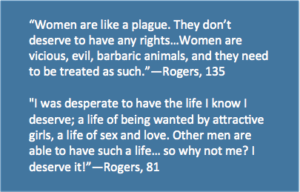
His viewpoints are a reflection of misogynistic beliefs of many men who are part of the anti-feminist backlash, illustrated on online forums specifically targeting women. His actions cannot be separated from a larger discussion of the implications of rampant sexism in our culture.
Elliot Rodgers is seen as a hero amongst “incel” communities. “Incel” is shorthand for the term “involuntary celibates,” and refer to male members of an online subculture who define themselves as unable to find a romantic or sexual partner despite desiring one. Incels commune in online forums, hosting discussions and using language characterized by resentment, misogyny, misanthropy, self-pity and self-loathing, racism, a sense of entitlement to sex, and the endorsement of violence against sexually active people, specifically women.
Video games are often violent, sexist, and objectifying of womxn, but Grand Theft Auto is one of the more extreme examples. The only female-presenting characters in the game exist to be groped, pursued, raped, and even murdered. GTA is clearly catered towards men (with no other available protagonist), and it encourages players to act violently and disrespectfully towards femme characters. Here are some examples:

- In the car, players tune into a radio station that advises them to crush a woman’s sternum during sex because “most women love that.”
- A large part of the game can be spent in strip clubs and with sex workers. Having sex with these women increases the player’s stamina points, and many forums encourage running over sex workers with a car.
- When in the strip club, lap dances consist of trying to grope the woman while the guards are not paying attention.
- Sometimes topless women can be seen through the window at a particular mansion and the player can snap pictures of these women.
- Some users have altered the code of the game in order to rape other players.
- If the player follows a woman on the street, she will get uncomfortable and speed up while looking over her shoulder.
- If you are inactive during the game for some time, the character takes control of the camera and starts zooming in on women’s bodies.
Victim blaming is another element of Rape/Relationship Abuse Culture. Putting the blame on the victim/survivor shifts the focus from the perpetrator (those who choose to do harm) and makes it seem as though the survivor is responsible for being abused or raped. Saying things like “they was asking for it,” because of how a womxn was dressed or how intoxicated they were at the time of being assaulted or “they provoked it,” when a person is hit or verbally abused are victim blaming statements. There are a number of ways that victim blaming occurs in our society, both on the interactional level and on a larger cultural level. We need to develop a culture that holds perpetrators accountable and that offers support and understanding towards survivors.
Steubenville Rape Case
In Steubenville, Ohio, in August, 2012, two football players raped an unconscious high school girl, while bystanders took pictures and tweeted about the events. Here are some of the bystanders’ disturbing, misogynistic comments:
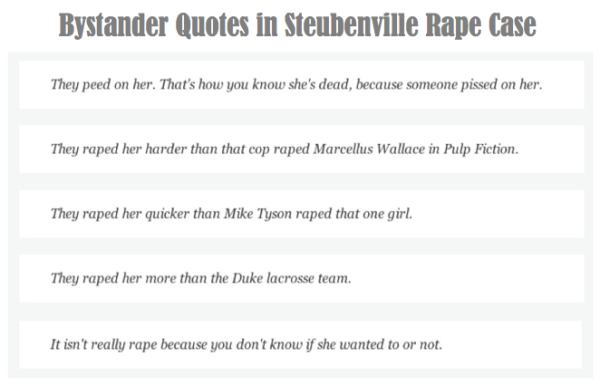
Instead of focusing on the perpetrator (and the many bystanders), the media response was to blame the victim:
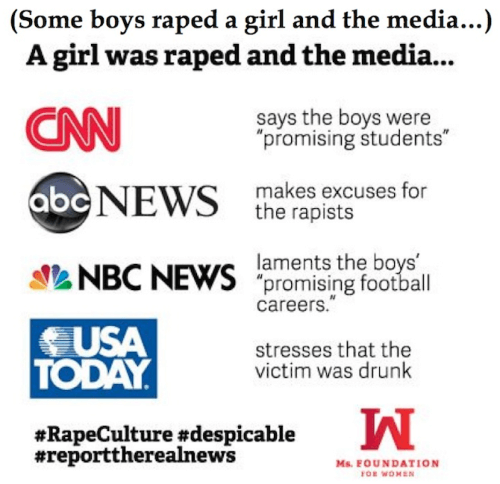
Chris Brown

In 2009, Chris Brown beat Rihanna and pictures surfaced of her bloodied face. After this information became public, society did not focus on Chris Brown’s horrifying actions, but instead blamed Rihanna, the victim. The media and general public blamed her for the abuse. Here are some examples of from comments on MTV.com:
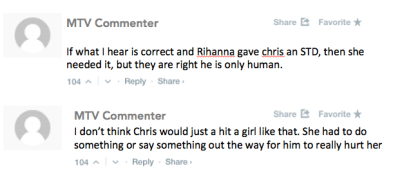
Not only are the above examples strangely empathetic towards the person who perpetrated the violence, but we know that someone cannot provoke their partner into being abusive.
FAQ Explanation Abuse is always a choice that a perpetrator makes to harm.
Here is an account of what really happened, taken from Chris Brown’s affidavit:

Even after the horrific facts of the case were made public, the victim blaming went on. People continued to victim-blame her by focusing on “why she went back” instead of asking “why did Chris Brown do this?” or “why does our society continue to accept domestic violence?” It is important to remember that the perceived “choice” to stay with Brown (or others we see in the media) is often based on the fear of retaliation by a very powerful public figure. The reality is that the most dangerous time for a survivor/victim is when they leave the abusive partner; 75% of domestic violence related homicides occur upon separation. See Barriers to Leaving an Abusive Relationship for more information on why it is difficult to leave an abusive partner and why we shouldn’t focus on that.
Ray Rice
The case of Baltimore Ravens running back Ray Rice elicited a national outcry and one of the largest discussions about domestic violence, the implications of victim blaming and the presence of rampant desensitization towards violence against womxn in sports and elsewhere. When a video surfaced of Rice dragging Janay Palmer’s unconscious body after punching her out in an elevator, the response from all directions was to blame Janay Palmer and excuse Ray Rice. Roger Goodell, commissioner of the NFL, called the abuse “a terrible mistake.” John Harbaugh, Ravens coach, said that the assault was due to “couples issues” and said publicly that he hadn’t seen anything to suggest that Rice wouldn’t be back on the field next season. In an unbelievable example of victim blaming, the Baltimore Ravens tweeted:

Sports commentator Stephen A. Smith, on national television, responded to the video by accusing women of provoking and causing the abuse perpetrated against them.
It was not until a second video surfaced which shows Rice dealing Palmer the blow that knocked her unconscious that the Ravens fired him and the NFL suspended him indefinitely, as the Ravens had previously only suspended him for two games. But why does it take this video, which forces Janay Palmer to relive the abuse, for anyone to take real action? Ray McDonald, 49ers defensive lineman was arrested for a domestic violence felony, yet he is still playing. Greg Hardy, defensive end for the Panthers, was found guilty of abuse and death threats towards his ex-girlfriend…and is still playing. Terrell Suggs, another Panthers player, is still playing despite the fact that his partner has come out with horrifying stories of abuse, including him punching her in the neck and pouring bleach on her and their son. Why are none of these men being held accountable for their actions? Because they don’t have video documentation? The fact that we needed “proof” beyond police reports is a problem. Our society does not believe womxn until the abuse is pushed so close to our faces that we no longer can look away.
And the victimization continues. The media is blaming Janay with headlines such as, “Why Does Janay Keep Standing By her Man? This illustrates the societal ignorance of the nature of abuse by assuming that if it were really dangerous, the victim would leave and she could do so easily. The reality is that upon separation, the risk that an abuser will retaliate and possibly commit homicide against womxn increases by 75%, for at least two years (LERC) and survivors know this. It happened when Jovan Belcher killed Cassandra Perkins. See Barriers to Leaving an Abusive Relationship for more information. Instead of putting the responsibility on Janay Palmer to leave, the media/NFL/courts should be demanding that Rice, and others, stop abusing.
Harvey Weinstein
Harvey Weinstein’s abuse and assault of women led to an increased focus on the issue of sexual violence and rape culture due to his high profile position as a Hollywood film producer and the sheer number of survivors who have spoken out against him.
In late 2017, over 100 women reported in the New York Times, the New Yorker and other outlets about Weinstein’s assaults on them. Weinstein raped them, appeared naked in front of them, forced them to massage him, offered them advancement in their careers in exchange for sexual favors and much more. He was removed from his company and many international film organizations, and subsequently charged with rape, criminal sex acts, sexual abuse, and sexual misconduct, leading to his arrest. Weinstein’s initial response to the allegations against him was a letter in which he claimed that being born in the 60s was the cause of his actions. His refusal to acknowledge his choice to abuse and assault illustrates the lack of accountability that permeates rape culture. The fact that he was able to abuse women at all also demonstrates that society allows people in power to feel like they can get away with treating women as sex objects. The idea that abuse is a natural and justified consequence of power is rape culture.
The actions of Harvey Weinstein, and the flood of reporting as a result, reignited an international social media campaign, #MeToo, started by Tarana Burke. This movement was a call of awareness in which people shared their stories of men sexually assaulting or harassing them; they did this in order to force the conversation about the need for change to the forefront of society. While this conversation has raised awareness of the issue, it is also important to note that it places additional pressure on survivors to share their stories. Survivors should not feel responsible for subsequent actions by a perpetrator, and should not be blamed for not having come forward “sooner” or when society would like them to. This is another aspect of rape culture. Thus far, the MeToo movement has resulted in an unprecedented amount of media attention and political discourse, but it has also been met with backlash. This backlash includes questioning of whether survivors’ experiences were “bad enough” to be worth reporting. Abusers like Weinstein have continued to hold power because questions like this lead to survivors only feeling safe enough to report perpetrators when they feel that enough other survivors share that experience for them to be believed. This backlash undermines and belittles not only the survivors who have come forward, but all those who might ever be affected by sexual assault.
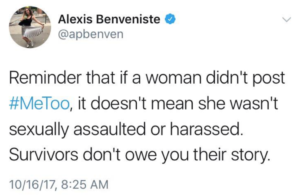

Donald Trump
Donald Trump was recorded crudely objectifying women and bragging about his ability to get away with sexual harassment and assault due to his celebrity status. In the recording he says, “I did try and f*ck her. She was married. … I moved on her like a b*tch. But I couldn’t get there. And she was married. Then all of a sudden I see her, she’s now got the big phony tits and everything. She’s totally changed her look. … Yeah, that’s her. With the gold. I better use some Tic Tacs just in case I start kissing her. You know, I’m automatically attracted to beautiful — I just start kissing them. It’s like a magnet. Just kiss. I don’t even wait. And when you’re a star, they let you do it. You can do anything. … Grab ’em by the p*ssy. You can do anything.”
Bragging about sexual assault is rape culture. Objectifying womxn is rape culture. The reaction to Trump’s words, by labelling the conversation as merely “locker room talk” is rape culture. The lack of accountability is rape culture.

Gender norms refer to the standards that are placed upon individuals in a society to present, act, and express themselves based upon their assigned sex at birth. Gender norms are built upon the assumption of a gender binary, which upholds the existence of only two opposite genders, male and female. Extensive research has been conducted on the social construction of gender, which posits that “gender” itself is a combination of social expectations that work to dictate how people should perform in order to be aligned with community definitions of each sex. This theory opened the door to our understanding of gender identity, or an individual person’s own sense of gender. A person who identifies as nonbinary does not align themselves with either male or female gender identities, and person who identifies as genderqueer may depart from the gender binary entirely, or incorporate traditional male and female gender qualities into their identity.
The idea of the gender binary excludes nonbinary and genderqueer individuals, and is often used as a rationale for undervaluing or stereotyping womxn. For example, womxn politicians can face immense backlash when running for office due to widespread beliefs that womxn are “too emotional.” This example showcases how gender norms contributes to gender role expectations.Gender role expectations refer to the societal norms that state individual’s that dictate what constitutes “manhood” and “womanhood.” From an early age, we are socialized by our parents, peers, and the world around us to act out our assigned gender at birth. Youth learn that there are certain things they should be doing, and certain things they are not allowed to do, and this education continues into adulthood. In our patriarchal society, to be a “woman” is to be soft-spoken, emotional, beautiful, and attentive to male needs, and to be a man is to be physically strong, unemotional, aggressive, sexually advanced, and rejecting of all things feminine. The patriarchy continues to hold onto these gender role expectations as social law because it is a core component of institutionalized sexism and systemic discrimination that benefit men in positions of power. These gender role expectations uniquely target transgender, nonbinary, and genderqueer individuals. Transphobia, the fear and hatred of transgender people, is partially founded upon the idea that gender is rigid and that transgender individuals are either confused or mentally ill for subverting gender role expectations. Transgender people are not confused; they have every right to express their gender the way they see fit.
These gender roles constrain all individuals and contribute to the abusive mindset and victim-blaming attitudes. This includes men.
The negative impact of gender roles on men can be seen in the phenomenon of toxic masculinity. Toxic masculinity refers to the harmful social norms that are aimed at men and boys, which promote the idea that masculinity or expressing masculinity is the most important part of being a male. This does not mean that all men are bad, and it does not mean that all masculine traits are bad. Toxic masculinity allows us to analyze which gender role expectations are actually hurting men and boys, and our entire society. An example of toxic masculinity is the commonly used phrase “boys don’t cry.” While this phrase by itself may not seem harmful, it is actually just one part of an entire system that teaches men and boys that they cannot express emotion, and, if they do, they lose their masculinity and will be shunned by others. This leads to men who repress their emotions and have a difficult time opening up to others, which could be correlated with high depression and suicide rates among men in the United States. Toxic masculinity, like gender role expectations, hurts everyone. Toxic masculinity encompasses men’s feelings of entitlement to womxn’s bodies and the glorification of sex as a “conquest,” which all contribute to the objectification and dehumanization of womxn.
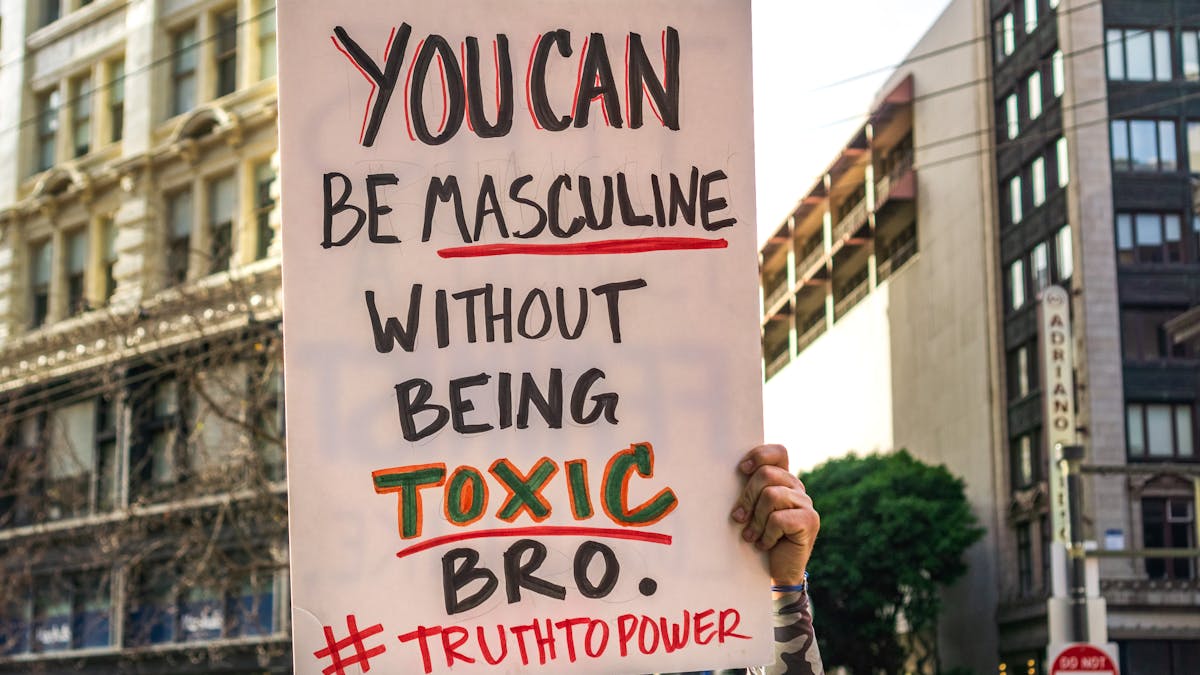
Misogynistic themes are highly common in mainstream media and misogynistic attitudes have thus become internalized due to this prevalence. Nonbinary and genderqueer individuals experience layers of violence due to sexist beliefs and attitudes. The patriarchy values masculinity and male qualities, and an example of how this manifests towards nonbinary and genderqueer people is through purposeful misgendering, the use of a person’s incorrect pronouns. Mainstream media has largely ignored the existence of nonbinary and genderqueer individuals, and there continues to be a major lack of nonbinary and genderqueer representation. This forced invisibility is detrimental to the safety and wellbeing of nonbinary and genderqueer people. By excluding them from mainstream media, patriarchal society effectively strips nonbinary and genderqueer individuals of their autonomy, empowering men who perpetrate violence against them.
Trans-misogyny, which refers to the hatred of trans women, and transphobia, prejudice towards transgender individuals, are both major components of rape culture. Misgendering is also highly common towards trans people, and is a result of the rigid gender roles that the patriarchy has constructed. Anti-transgender rhetoric, attitudes, and representation all contribute to the demonization and dehumanization of transgender individuals. As stated by the Mazzoni Center, “Part of the problem is that trans communities, particularly trans women, who are hyper-sexualized by society, are further victimized by a rape culture that tells them they are responsible for their own sexual assault. This victim-blaming that occurs creates an atmosphere of distrust in the police which leads most sexual assaults men perpetrate against trans women to go unreported.” Our society also sidelines transgender representation in movies, television shows, and media of every kind (similarly to nonbinary and genderqueer individuals). Historically, the majority of content that featured the experiences of transgender individuals were full of outdated stereotypes, and painted them either as murder victims or as mentally ill. This continued discrimination caused many in society to internalize these concepts about transgender individuals, which contributes to the discrimination directed towards transgender people. The invisibility of positive and realistic trans depictions, combined with the hyper-visibility of transgender people as victims of men’s violence against them, lead to the stifling of transgender individuals’ accomplishments, activism, and autonomy.

Tony Porter, in a TED talk, provides a moving example of how societal ideas about masculinity contribute to rape culture and acceptance of violence against womxn.
In response to the Chiefs hanging up Jovan Belcher’s jersey as a way of memorializing someone who had murdered the young mother of his infant, Joe Samalin, Sacchi Patel, and Ben Atherto-Zeman from MasculinityU wrote this short piece:

Check out our Guys Getting Involved page and Feminism in Action for more ideas on how to combat rape culture
This page was created by a Next Generation Intern from the Center for Relationship Abuse Awareness.
